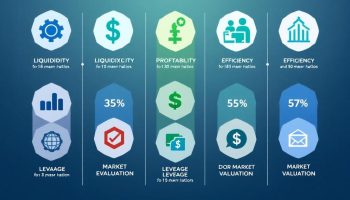
Strategic Risk Management
Strategic risk management transforms threats into opportunities for resilience and competitive advantage. By implementing a systematic framework that identifies, assesses, and responds to risks across competitive, regulatory, reputational, and operational areas, you can navigate high-risk environments with confidence and strategic flexibility.
Key Takeaways:
- Strategic risk management is critical, with 85% of business owners operating in moderate to high-risk environments.
- Effective risk strategies require systematic identification, assessment, and response planning across multiple organizational domains.
- Technology and AI are increasingly important in enabling predictive risk detection and sophisticated management approaches.
- Less than 50% of organizations effectively evaluate strategic risk exposures, presenting a significant opportunity for competitive differentiation.
- Leadership commitment and cross-functional engagement are essential for building a risk-aware organizational culture.
Risk exposure varies dramatically across industries, but developing a structured risk strategy helps organizations thrive amid uncertainty. Your risk management approach shouldn’t just protect against downside scenarios but position your company to capitalize on emerging opportunities.
The most successful companies conduct regular scenario planning exercises to anticipate potential disruptions. These exercises help maintain operational continuity while competitors struggle with unexpected challenges. A recent analysis found that companies with advanced risk management capabilities outperform peers by up to 20% in long-term value creation.
Digital solutions now offer unprecedented capabilities for risk monitoring. Implementing a real-time risk dashboard provides immediate visibility into changing risk factors, allowing for faster decision-making when conditions shift unexpectedly.
Creating a risk-aware culture starts with clear communication from leadership. Employees at all levels need to understand their role in identifying and reporting potential risks. This cultural shift turns risk management from a specialized function into a company-wide capability and competitive advantage.
“In a world where 85% of businesses face moderate to high-risk environments, a robust risk management strategy is not just a necessity but a competitive advantage. By harnessing technology and fostering a risk-aware culture, organizations can turn strategic threats into opportunities for resilience and growth.”
The Evolving Landscape of Strategic Risk
Strategic risk management (SRM) has become a fundamental process that you need to implement across your organization to navigate today’s complex business challenges. In dynamic business environments, your ability to identify, assess, and respond to strategic risks can mean the difference between long-term success and failure. The importance of effective risk response planning can’t be overstated, with 85% of business owners now operating in moderate to high-risk environments.
Your board members likely recognize this shift—79% view improved risk management as critical for future protection. This reflects growing awareness that traditional risk strategy examples and approaches aren’t adequate for today’s challenges. You must develop a comprehensive risk appetite framework that addresses both obvious and hidden threats to your strategic objectives.
Components of Effective Strategic Risk Strategy
Creating a robust risk strategy example requires understanding several key components:
- Risk Identification Framework: Systematically catalog all potential risks across competitive, regulatory, reputational, and operational domains
- Risk Assessment Criteria: Evaluate each risk based on likelihood, impact, velocity, and interconnections
- Risk Response Planning: Develop specific strategies to avoid, transfer, mitigate, or accept identified risks
- Monitoring Mechanisms: Implement continuous oversight to track risk evolution and response effectiveness
- Governance Structure: Establish clear responsibilities for risk oversight at all organizational levels
Strategic risks are inherently interconnected, creating potential cascading effects throughout your organization. For instance, a compliance failure can quickly transform into a reputational crisis, which might then trigger competitive challenges. Less than 50% of organizations effectively evaluate these strategic risk exposures, leaving them vulnerable to unforeseen threats.
The most successful risk response strategies integrate quantitative approaches like Economic Capital measurement and Risk-Adjusted Return on Capital (RAROC) methodologies. These provide your organization with data-driven insights to make informed decisions about risk tolerance levels and mitigation priorities.
Technology now plays a crucial role in modern risk strategy examples, with AI and analytics enabling more sophisticated detection capabilities. You can leverage these tools to move beyond reactive management toward predictive risk identification, creating a competitive advantage from your risk management approach.
Organizations that do not prioritize strategic risk management are 70% more likely to fail within the next five years compared to those with robust strategies.
forbes.com
Strategic Risks: Identifying and Understanding Threats
Understanding strategic risks is essential for building organizational resilience. You need a comprehensive risk strategy example framework to navigate today’s volatile business landscape. With 85% of business owners operating in moderate to high-risk environments, identifying potential threats early is no longer optional but necessary.
Strategic risks directly impact your organization’s ability to achieve business objectives. These threats can undermine your competitive position and erode shareholder value if left unaddressed. A structured approach to risk identification helps you prioritize resources and develop effective risk response strategies.
Key Strategic Risk Categories
You’ll encounter various strategic risk categories that require different mitigation approaches:
- Competitive risks – Emerging market entrants, disruptive innovations, or shifting customer preferences that threaten your market position
- Change management risks – Challenges associated with organizational transformations, mergers, or new technology adoption
- Regulatory compliance risks – Evolving legal requirements that impact your operations and create potential liability
- Reputational risks – Threats to brand equity and public perception that can damage customer trust
- Political and economic risks – Geopolitical instability, trade restrictions, or economic downturns affecting business continuity
- Governance and operational risks – Weaknesses in oversight processes that create vulnerability
These risks rarely exist in isolation. The interconnected nature of strategic threats often creates cascading effects throughout your organization. For example, a regulatory compliance failure can quickly evolve into a significant reputational risk that damages your competitive position.
Understanding risk relationships is crucial since less than 50% of organizations effectively evaluate their strategic risk exposures. This oversight creates blind spots in your risk response planning process.
A robust risk strategy example should incorporate both quantitative and qualitative assessment methods. Economic capital measurement techniques and Risk-Adjusted Return on Capital (RAROC) methodologies help you quantify potential impacts, while scenario analysis explores how different risk factors might interact under various conditions.
The most effective approach combines board-level engagement with cross-functional implementation. With 79% of board members viewing improved risk management as critical for future protection, leadership commitment is essential for fostering a risk-aware culture throughout your organization.
By incorporating risk assessment into your strategic planning processes, you’ll transform potential threats into opportunities for competitive advantage. This proactive stance on risk management creates the strategic flexibility needed to navigate uncertainty while protecting organizational value.

Quantitative Approaches to Risk Management
Effective risk strategy examples rely on quantifiable methods to identify, assess, and mitigate potential threats. When you implement a structured quantitative approach to risk management, you’ll transform uncertain variables into measurable factors for more informed decision-making.
Economic capital measurement stands at the forefront of quantitative risk assessment. This technique helps you quantify potential losses across various risk categories, creating a financial buffer that protects your organization from unexpected events. Your risk strategy example should include capital allocations based on calculated risk exposure rather than arbitrary reserves.
The Risk-Adjusted Return on Capital (RAROC) methodology offers another powerful risk strategy example for your organization. RAROC allows you to compare investment opportunities on an equal risk-adjusted basis by:
- Calculating expected returns against potential risks
- Factoring risk costs into profitability assessments
- Providing a standardized comparison across business units
- Guiding capital allocation to maximize risk-adjusted performance
Leading and lagging indicators create a comprehensive risk monitoring system in your risk management framework. These indicators help you track:
- Customer satisfaction metrics (leading)
- Market share fluctuations (lagging)
- Employee engagement scores (leading)
- Revenue growth patterns (lagging)
- Supplier quality issues (leading)
Scenario analysis represents another critical component in any effective risk response planning strategy. This technique allows you to evaluate multiple potential outcomes and develop appropriate response strategies before problems materialize. Less than 50% of organizations effectively evaluate strategic risk exposures through scenario planning, presenting an opportunity for competitive advantage.
Technology integration has revolutionized risk detection capabilities. Your risk strategy example should incorporate tools like:
| Technology Solution | Risk Management Application |
|---|---|
| AI-powered analytics | Pattern recognition in risk data |
| Automated dashboards | Real-time risk monitoring |
| Predictive modeling | Forward-looking risk assessment |
| Blockchain systems | Transparent risk transaction records |
Advanced Quantitative Risk Frameworks
Monte Carlo simulations provide sophisticated risk assessment capabilities by running thousands of potential scenarios. This risk strategy example helps you understand the probability distribution of possible outcomes rather than relying on single-point estimates.
Risk-weighted scoring systems enable you to prioritize threats based on both impact and likelihood. Your risk strategy example should include a formalized matrix that guides resource allocation toward the most critical risks while monitoring lower-priority concerns.
Creating a comprehensive quantitative risk framework requires integration with risk appetite and tolerance levels. These predefined thresholds establish boundaries for acceptable risk-taking and trigger response actions when metrics approach critical levels.
Organizations that integrate quantitative risk management strategies are 60% more likely to achieve their strategic objectives.
hbr.org
Building a Risk-Aware Organizational Culture
Developing a solid organizational culture where risk strategy examples are integrated into daily operations can transform your approach to potential threats. You need to establish risk awareness as part of your company’s DNA, not just as an isolated department’s responsibility. Creating this environment requires deliberate effort and commitment from all levels.
Leaders play a critical role in building risk-aware cultures. Your executive team and board members must actively champion the risk management process by allocating adequate resources and consistently communicating its importance. When leadership demonstrates commitment to effective risk response planning, employees follow suit.
The most successful organizations integrate risk considerations into their strategic planning processes. This means you’ll need to:
- Conduct regular risk awareness training sessions for all staff members
- Create clear risk escalation protocols and communication channels
- Establish risk strategy examples that can be easily understood and applied
- Reward employees who identify and mitigate potential risks
- Include risk management performance in employee evaluations
- Develop cross-functional risk committees with representatives from various departments
Continuous risk monitoring requires you to implement both formal and informal assessment mechanisms. Regular risk reviews, dashboards, and early warning systems help track emerging threats before they become crises. Your organization should develop risk response strategies that address various scenarios, allowing for quick action when needed.
Proactive Risk Response Mechanisms
Proactive organizations don’t just identify risks—they develop comprehensive response plans. Your risk strategy example should include:
- Pre-approved risk mitigation templates for common scenarios
- Decision trees that guide response actions based on risk severity
- Delegation of authority frameworks for rapid decision-making
- Regular testing of response protocols through simulations
- Post-event analysis to refine future risk responses
Cross-functional risk awareness breaks down departmental silos that often hide risks. You’ll need to create structures that encourage information sharing about potential threats across your organization. This collaborative approach ensures risks that affect multiple areas aren’t overlooked due to limited perspectives.
With less than 50% of organizations effectively evaluating strategic risk exposures, your business can gain competitive advantage through superior risk management practices. By embedding risk strategy examples throughout your operational framework, you’ll build resilience against unexpected challenges and position your organization to thrive even in uncertain conditions.
Expert Insight: To build a risk-aware organizational culture, integrate risk considerations into daily operations and make risk management a shared responsibility across all levels. Leadership plays a pivotal role; executives must champion risk awareness by allocating resources and fostering open communication about its significance. By embedding risk strategy examples in training, evaluations, and cross-departmental collaboration, your organization can enhance resilience and proactively address potential threats.
Technology and Advanced Risk Management
You need cutting-edge tools to manage today’s complex risk landscape effectively. Modern technology has revolutionized how organizations identify, assess, and mitigate strategic risks. Implementing a comprehensive risk strategy example involves leveraging advanced solutions that transform traditional approaches.
AI and analytics have become essential components of sophisticated risk detection systems. These technologies can identify patterns and anomalies that human analysts might miss, providing early warning signals before risks materialize. Your risk strategy example should incorporate machine learning algorithms that continuously improve threat detection accuracy while processing vast amounts of data across your organization.
Consider these key technological advancements for your risk strategy example:
- Automated risk rating tools that standardize assessment processes
- Predictive analytics that forecast potential risk scenarios
- Real-time monitoring dashboards for continuous risk surveillance
- Cloud-based risk management platforms enabling cross-functional collaboration
- Blockchain solutions for secure risk data management
Cybersecurity has emerged as a critical component of any effective risk response planning framework. Your risk strategy example should address digital threats through multi-layered protection systems, including vulnerability scanning, penetration testing, and incident response protocols.
Data-Driven Decision Making
The most successful risk strategy examples rely on data-driven approaches. You can transform uncertainty into measurable variables through:
- Quantitative risk modeling that assigns numerical values to potential threats
- Scenario analysis tools that simulate various risk conditions
- Sensitivity testing to evaluate response effectiveness
- Risk appetite frameworks calibrated through data analytics
Technology integration delivers comprehensive risk assessment matrix examples that connect previously siloed information. Your organization will benefit from holistic views of interconnected risks, enabling more informed strategic decisions.
With less than 50% of organizations effectively evaluating strategic risk exposures, implementing advanced technology solutions provides significant competitive advantage. Your risk strategy example should emphasize how these tools enable faster response times, more accurate risk prioritization, and better resource allocation.
Remember that technology alone isn’t enough—you must pair these tools with skilled risk professionals who can interpret results and develop appropriate mitigation strategies. The most successful risk strategy examples demonstrate how technology augments human expertise rather than replacing it.
Strategic Risk as a Competitive Advantage
Turning risk into opportunity sets exceptional organizations apart from their peers. When you develop a robust risk response strategy, you don’t just protect your business—you position it to thrive amid uncertainty. A well-crafted risk strategy example demonstrates how this transformation occurs.
The most successful companies view risk management not as defensive but as offensive. This perspective shift creates tangible competitive advantages in several ways. You’ll gain enhanced decision-making capabilities when risks are systematically evaluated against potential rewards. This balancing act is essential for any risk strategy example to demonstrate effectiveness.
Consider how you can develop a risk strategy example that works for your organization:
- Identify strategic risks specific to your industry
- Evaluate potential impact on key business objectives
- Create response plans that mitigate threats while capturing opportunities
- Implement continuous monitoring systems
- Regularly test risk responses through simulation exercises
The following table illustrates how different organizations have transformed risks into advantages:
| Risk Type | Traditional Approach | Competitive Advantage Approach | Outcome |
|---|---|---|---|
| Regulatory change | Compliance-focused | Anticipatory positioning | Market leadership during transitions |
| Technological disruption | Defensive protection | Early adoption and innovation | New revenue streams |
| Market volatility | Risk avoidance | Strategic flexibility | Stability during downturns |
These approaches demonstrate why strategic risk management has become crucial, with 85% of business owners operating in moderate to high-risk environments. Your risk appetite and tolerance will determine how aggressively you pursue these advantages.
Technology Integration for Strategic Risk Advantage
Technology dramatically enhances your risk strategy capabilities. Advanced analytics and AI now enable organizations to predict emerging risks with greater accuracy. You can implement these tools to develop a competitive edge:
- Predictive risk modeling software
- Real-time data visualization dashboards
- Automated risk scoring systems
- Scenario planning platforms
These technologies support a comprehensive risk strategy example by providing deeper insights than traditional approaches. According to recent studies, less than 50% of organizations effectively evaluate strategic risk exposures, creating an opportunity for competitive differentiation through effective risk response planning.
The most successful organizations don’t just manage risk—they harness it as a catalyst for innovation and growth. Your risk strategy example should demonstrate how potential threats can be transformed into strategic opportunities that drive business value and resilience.






